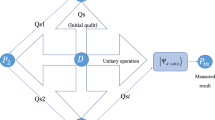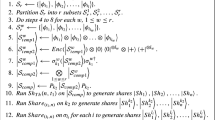Abstract
In general, in a secret sharing scheme, the dealer chooses shares and distributes them to the participants securely. For the secure communication, each participant must have their own secret key. In this paper, a lattice-based threshold secret sharing scheme has been proposed, where participants choose their shares and securely send to the dealer. So, the participants need not have their secret keys. The proposed scheme is verifiable, multi-use, multi-stage, and single-share in nature. Single-share nature means common participants can have a single share corresponding to many secrets even if the sets of shareholders are not the same. This scheme can be used efficiently to reduce the storage requirement for storing the participants’ shares. The proposed scheme is secure under the hardness of solving \(n^c\)-approximate shortest vector problem (SVP) over lattices. So, the proposed scheme is safe against quantum computers.


Similar content being viewed by others
References
Chunying W, Shundong L, Yiying Z. Key management scheme based on secret sharing for wireless sensor network. In: Fourth International Conference on Emerging Intelligent Data and Web Technologies (EIDWT); 2013. p. 574–8.
Attasena V, Harbi N, Darmont J, et al. Sharing-based privacy and availability of cloud data warehouses. In: 9èmes journées francophones sur les Entrepôts de Données et l’Analyse en ligne; 2006. p. 17–32.
Schoenmakers B. A simple publicly verifiable secret sharing scheme and its application to electronic voting. In: Advances in CryptologyCRYPTO99, Springer; 1999. p. 148–64.
Stadler M. Publicly verifiable secret sharing. In: Advances in Cryptology EUROCRYPT 96, ser. Lecture Notes in Computer Science, vol. 1070; 1996. p. 190–9.
Cramer R, Damgard I, Maurer U. General secure multi-party computation from any linear secret sharing scheme. In: Preneel, B. (ed.) EUROCRYPT 2000, LNCS, vol. 1807; 2000. p. 316–34.
Shamir A. How to share a secret. Commun ACM. 1979;22(11):612–3.
Blakley GR. Safeguarding Cryptographic Keys. In: Proceedings of the 1979 AFIPS National Computer Conference, vol. 48; 1979. p. 313–7.
Shor PW. Algorithms for quantum computation: discrete logarithms and factoring. In: Proceedings of the 35th Annual Symposium on Foundations of Computer Science, ser. SFCS ’94. Washington, DC, USA: IEEE Computer Society; 1994. p. 124–34.
Mignotte M. How to share a secret? In: Beth, T. (ed.) Cryptography - EUROCRYPT 1982, LNCS, vol. 149; 1982. p. 371–5.
Asmuth C, Bloom J. A modular approach to key safeguarding. IEEE Trans Inf Theory. 1983;29(2):208–10.
Chor B, Goldwasser S, Micali S, Awerbuch B. Verifiable secret sharing and achieving simultaneity in the presence of faults. In: Proceeding of 26th Annual Symposium on Foundations of Computer Science; 1985. p. 383–95.
Benaloh JC. Secret sharing homomorphisms: kee** shares of a secret secret. In: Proceedings on Advances in Cryptology- CRYPTO86; 1987. p. 251–60.
Feldman P. A practical scheme for non-interactive verifiable secret sharing, SFCS ’87: Proceedings of the 28th Annual Symposium on Foundations of Computer Science; 1987. p. 427–38.
Martin K, Safavi-Naini R, Wang H. Bounds and techniques for efficient redistribution of secret shares to new access structures. Comput J. 1999;42(8):638–49.
Barwick SG, Jackson WA, Martin K. Updating the parameters of a threshold scheme by minimal broadcast. IEEE Trans Inf Theory. 2005;51(2):620–33.
Blundo C, Santis AD, DiCrescenzo G, Gaggia AG, Vaccaro U. Multi-secret sharing schemes. In: Advances in CryptologyCRYPTO94, Springer; 1994. p. 150–63.
He J, Dawson E. Multistage secret sharing based on one-way function. Electron Lett. 1994;30(19):1591–2.
Pang L, Li H, Wang Y. An efficient and secure multi-secret sharing scheme with general access structures. Wuhan Univ J Nat Sci. 2006;11(6):1649–52.
Chang TY, Hwang MS, Yang WP. A new multi-stage secret sharing scheme using one-way function. SIGOPS Oper Syst Rev. 2005;39(1):48–55.
Das A, Adhikari A. An efficient multi-use multi-secret sharing scheme based on hash function. Appl Math Lett. 2010;23(9):993–6.
Chang TY, Hwang MS, Yang WP. An improved multi-stage secret sharing scheme based on the factorization problem. Inf Technol Control. 2011;40(3):246–51.
Georgescu A. A LWE-based secret sharing scheme, IJCA Special Issue on Network Security and Cryptography, vol. NSC(3); 2011. p. 27–9.
Bansarkhani RE, Meziani M. An efficient lattice-based secret sharing construction. In: Information Security Theory and Practice. Security, Privacy and Trust in Computing Systems and Ambient Intelligent Ecosystems, ser. Lecture Notes in Computer Science. I. Askoxylakis, vol. 7322; 2012. p. 160–8.
Ajtai M. Generating hard instances of lattice problems (extended abstract). In: Proceedings of the Twenty-eighth Annual ACM Symposium on Theory of Computing, ser. STOC ’96. New York, NY, USA: ACM; 1996. p. 99–108.
Khorasgani HA, Asaad S, Eghlidos T, Aref M. A lattice-based threshold secret sharing scheme. In: 11th International ISC Conference on Information Security and Cryptology; 2014. p. 173–9.
Babai L. On Lovász’ lattice reduction and the nearest lattice point problem. Combinatorica. 1986;6(1):1–13.
Dehkordi MH, Ghasemi R. A lightweight public verifiable multi secret sharing scheme using short integer solution. Wirel Pers Commun. 2016;91(3):1459–69.
Pilaram H, Eghlidos T. An efficient lattice-based multi-stage secret sharing scheme. IEEE Trans Dependable Secur Comput. 2017;14(1):2–8.
Pilaram H, Eghlidos T. A lattice-based changeable threshold multi-secret sharing scheme and its application to threshold cryptography. Scientia Iranica. 2017;24:1448–57.
Yang Z, He D, Qu L, Xu J. On the security of a lattice-based multi-stage secret sharing scheme. IEEE Trans Dependable Secure Comput. 2023;20(5):4441–2.
Rajabi B, Eslami Z. A verifiable threshold secret sharing scheme based on lattices. Inf Sci. 2019;501:655–61.
Gentry C, Halevi S, Lyubashevsky V. Practical non-interactive publicly verifiable secret sharing with thousands of parties. Cryptology ePrint Archive: Report 2021/1397; 2021.
Kiamari N, Hadian M, Mashhadi S. Non-interactive verifiable LWE-based multi secret sharing scheme. Multimed Tools Appl. 2023;82:22175–87.
Acknowledgements
This work is supported under CSIR-JRF (File number 09/1032(0022)/2020-EMR-I).
Author information
Authors and Affiliations
Corresponding author
Ethics declarations
Conflict of Interest
On behalf of all authors, the corresponding author states that there is no conflict of interest.
Additional information
Publisher's Note
Springer Nature remains neutral with regard to jurisdictional claims in published maps and institutional affiliations.
This article is part of the topical collection “Research Trends in Communication and Network Technologies” guest edited by Anshul Verma, Pradeepika Verma, and Kiran Kumar Pattanaik.
Rights and permissions
Springer Nature or its licensor (e.g. a society or other partner) holds exclusive rights to this article under a publishing agreement with the author(s) or other rightsholder(s); author self-archiving of the accepted manuscript version of this article is solely governed by the terms of such publishing agreement and applicable law.
About this article
Cite this article
Kumar, R., Padhye, S. A Lattice-Based Single-Share Secret Sharing Scheme. SN COMPUT. SCI. 4, 811 (2023). https://doi.org/10.1007/s42979-023-02274-2
Received:
Accepted:
Published:
DOI: https://doi.org/10.1007/s42979-023-02274-2




